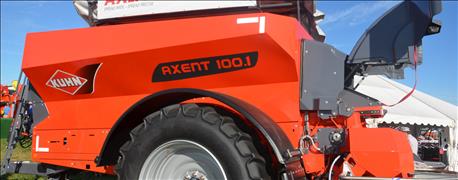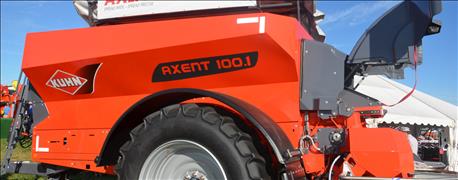
Transitioning from the horse to the tractor took at least 25 years, depending upon which tractor you consider to be the first practical farm tractor. There were naysayers in the early days, and giving up horses was a monumental mental challenge for some. The first yield monitor appeared roughly 25 years ago. Some said precision agriculture would be a flash in the pan, just a fad.
There have been ups and downs as some companies faded out and others moved in. But 25 years later, it’s obvious precision agriculture is fast becoming the new normal — the gold standard for how you will farm in the future.

PRECISION SPREADING: This state-of-the-art fertilizer spreader form Kuhn is called the 100.1 version for a reason. This is the first version of what must be one of the most precise fertilizer spreaders ever.
There were more signs of that trend at fall farm shows across the country in 2016. Robotic tractors from Case IH and New Holland grabbed headlines, but up and down the streets of various shows, there were dozens of companies out of the limelight offering implements and services that are more tied to precision farming than ever before.
You will learn about many of these as reports on new products from shows appear in this magazine and other Penton Ag publications throughout the next several months.
Here is a sampling of products that illustrate how companies are integrating precision technology into areas where you might never have imagined it would show up.
High-tech fertilizer application
You could soon say goodbye to the traditional, pull-behind spinner spreader. Orthman and Salford worked together to develop precise fertilizer application technology. Each introduces a new pull-behind two-wheel fertilizer cart that features the ability to carry two products, plus variable-rate fertilizer control. Hooked into the computer in the tractor cab, rates can change automatically on the go. You can control up to four individual sections. Learn more at orthman.com or salfordgroup.com.
Precision-driven manure application
Kuhn introduces a fertilizer spreader so revolutionary that even the name indicates it’s a high-tech machine. It’s the Axent 100.1 version, indicating there could be even more sophisticated models later. This large spreader features the ability to spread a 120-foot-wide swath with precision accuracy. Buy a different attachment for the back, and you have perhaps the first precision-application system for applying poultry litter. The machine can also apply lime accurately with this attachment. Learn more at kuhnnorthamerica.com.
Grain cart information transfer
How many times did you wonder what weight was showing on the grain cart scales after unloading on the go this fall? Agrimatics introduces the Libra Cart grain weighing system. Information can be transmitted wirelessly from the cart to the combine cab. It works as long as the equipment is within 400 to 500 feet of each other.
The Reap app from Scale-Tec is also all about weaving precision technology into harvest so you have pertinent information at your fingertips. You can access all you want to know about grain, including weight and moisture content, from the time it leaves the combine hopper until it arrives at its destination.
Contact agrimatics.com or scale-tec.com.
Add spraying flexibility
Make those multiple sets of nozzle bodies on your spray boom work for you. Hypro introduces Duo React, which allows you to switch nozzles on the go. Switch from one to another, or program two nozzles to spray at once. It eliminates the need for dual lines. Visit hyprospraytips.com.
About the Author(s)
You May Also Like




